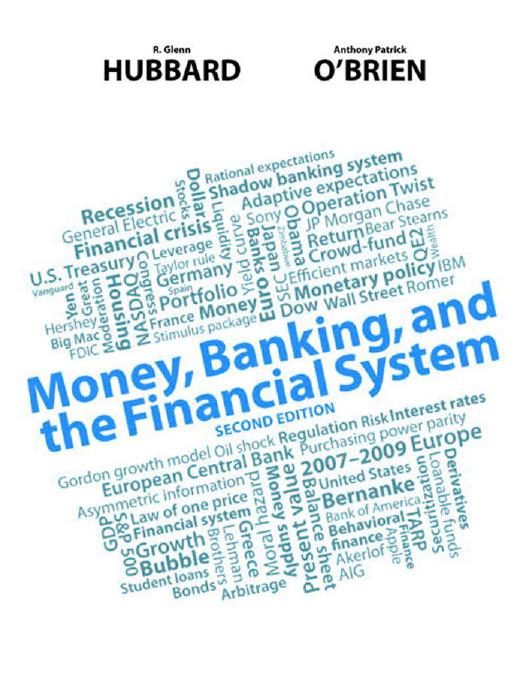Money Banking and the Financial System 2nd Edition by Glenn Hubbard, Anthony Patrick O’Brien ISBN 0133252191 9780133252194
$70.00 Original price was: $70.00.$35.00Current price is: $35.00.
Instant download Money Banking and the Financial System 2nd Edition after payment
Money Banking and the Financial System 2nd Edition by Glenn Hubbard, Anthony Patrick O’Brien – Ebook PDF Instant Download/Delivery: 0133252191, 9780133252194
Full download Money Banking and the Financial System 2nd edition after payment

Product details:
ISBN 10: 0133252191
ISBN 13: 9780133252194
Author: Glenn Hubbard, Anthony Patrick O’Brien
For students in the Money and Banking Economics course. This book is also suitable for readers interested in learning about money, banking, and the financial system in the context of contemporary events, policy, and business. Make the link between theory and real-world easier with the most up-to-date Money and Banking textbook on the market today! Hubbard/O’Brien’s textbook presents Money, Banking, and the Financial System in the context of contemporary events, policy, and business with an integrated explanation of today’s financial crisis. Reviewers tell us that Hubbard/O’Brien helps make the link between theory and real-world easier for students! The second edition retains the modern approach of the first edition, while incorporating several changes to address feedback from instructors and students and also to reflect the authors’ own classroom experiences. Available with MyEconLab! MyEconLab is a powerful assessment and tutorial system that works hand-in-hand with Money and Banking. MyEconLab includes comprehensive homework, quiz, test, and tutorial options, where instructors can manage all assessment needs in one program. Note: If you are purchasing the standalone text (ISBN: 0-13-299491-7) or electronic version, MyEconLab does not come automatically packaged with the text. To purchase MyEconLab, please visit: www.myeconlab.com or you can purchase a package of the physical text MyEconLab by searching the Pearson Higher Education web site. MyEconLab is not a self-paced technology and should only be purchased when required by an instructor.
Money Banking and the Financial System 2nd Table of contents:
Chapter 1: Introducing Money and the Financial System
-
Is Prosperity Just Around the Corner?
1.1 Key Components of the Financial System-
Financial Assets
-
Financial Institutions
-
Making the Connection: Microlending Aids U.S. Small Businesses
-
Making the Connection: What Do People Do with Their Savings?
-
The Federal Reserve and Other Financial Regulators
-
What Does the Financial System Do?
-
Solved Problem 1.1: The Services Securitized Loans Provide
1.2 The Financial Crisis of 2007–2009 -
Origins of the Financial Crisis
-
The Deepening Crisis and the Response of the Fed and Treasury
1.3 Key Issues and Questions About Money, Banking, and the Financial System -
Key Terms and Problems
-
Key Terms
-
Review Questions
-
Problems and Applications
-
Data Exercises
-
Chapter 2: Money and the Payments System
-
Who Hates the Federal Reserve?
2.1 Do We Need Money?-
Barter
-
The Invention of Money
-
Making the Connection: What’s Money? Ask a Taxi Driver!
2.2 The Key Functions of Money -
Medium of Exchange
-
Unit of Account
-
Store of Value
-
Standard of Deferred Payment
-
Distinguishing Among Money, Income, and Wealth
-
What Can Serve as Money?
-
The Mystery of Fiat Money
-
Making the Connection: Apple Didn’t Want My Cash!
2.3 The Payments System -
The Transition from Commodity Money to Fiat Money
-
The Importance of Checks
-
Electronic Funds and Electronic Cash
2.4 Measuring the Money Supply -
Measuring Monetary Aggregates
-
Making the Connection: Show Me the Money!
-
Does It Matter Which Definition of the Money Supply We Use?
2.5 The Quantity Theory of Money: A First Look at the Link Between Money and Prices -
Irving Fisher and the Equation of Exchange
-
The Quantity Theory Explanation of Inflation
-
Solved Problem 2.5: The Relationship Between Money and Income
-
How Accurate Are Forecasts of Inflation Based on the Quantity Theory?
-
The Hazards of Hyperinflation
-
What Causes Hyperinflation?
-
Making the Connection: Deutsche Bank During the German Hyperinflation
-
Should Central Banks Be Independent?
-
Answering the Key Question
-
Key Terms and Problems
-
Key Terms
-
Review Questions
-
Problems and Applications
-
Data Exercises
-
-
Chapter 3: Interest Rates and Rates of Return
-
Will Investors Lose Their Shirts in the Market for Treasury Bonds?
3.1 The Interest Rate, Present Value, and Future Value-
Why Do Lenders Charge Interest on Loans?
-
Most Financial Transactions Involve Payments in the Future
-
Compounding and Discounting
-
Solved Problem 3.1A: Using Compound Interest to Select a Bank CD
-
Solved Problem 3.1B: How Do You Value a College Education?
-
Discounting and the Prices of Financial Assets
3.2 Debt Instruments and Their Prices -
Loans, Bonds, and the Timing of Payments
-
Making the Connection: Interest Rates and Student Loans
3.3 Bond Prices and Yield to Maturity -
Bond Prices
-
Yield to Maturity
-
Yields to Maturity on Other Debt Instruments
-
Solved Problem 3.3: Finding the Yield to Maturity for Different Types of Debt Instruments
3.4 The Inverse Relationship Between Bond Prices and Bond Yields -
What Happens to Bond Prices When Interest Rates Change?
-
Making the Connection: Banks Take a Bath on Mortgage-Backed Bonds
-
Bond Prices and Yields to Maturity Move in Opposite Directions
-
Secondary Markets, Arbitrage, and the Law of One Price
-
Making the Connection: How to Follow the Bond Market: Reading the Bond Tables
3.5 Interest Rates and Rates of Return -
A General Equation for the Rate of Return on a Bond
-
Interest-Rate Risk and Maturity
-
How Much Interest-Rate Risk Do Investors in Treasury Bonds Face?
3.6 Nominal Interest Rates Versus Real Interest Rates -
Answering the Key Question
-
Key Terms and Problems
-
Key Terms
-
Review Questions
-
Problems and Applications
-
Data Exercises
-
-
Chapter 4: Determining Interest Rates
-
Are There Any Safe Investments?
4.1 How to Build an Investment Portfolio-
The Determinants of Portfolio Choice
-
Making the Connection: Fear the Black Swan!
-
Diversification
-
Making the Connection: How Much Risk Should You Tolerate in Your Portfolio?
4.2 Market Interest Rates and the Demand and Supply for Bonds -
A Demand and Supply Graph of the Bond Market
-
Explaining Changes in Equilibrium Interest Rates
-
Factors That Shift the Demand Curve for Bonds
-
Factors That Shift the Supply Curve for Bonds
-
Making the Connection: Why Are Bond Interest Rates So Low?
4.3 The Bond Market Model and Changes in Interest Rates -
Why Do Interest Rates Fall During Recessions?
-
How Do Changes in Expected Inflation Affect Interest Rates? The Fisher Effect
-
Solved Problem 4.3: Should You Worry About Falling Bond Prices When the Inflation Rate Is Low?
4.4 The Loanable Funds Model and the International Capital Market -
The Demand and Supply for Loanable Funds
-
Equilibrium in the Bond Market from the Loanable Funds Perspective
-
The International Capital Market and the Interest Rate
-
Small Open Economy
-
Large Open Economy
-
Making the Connection: Did a Global “Saving Glut” Cause the U.S. Housing Boom?
-
Answering the Key Question
-
Key Terms and Problems
-
Key Terms
-
Review Questions
-
Problems and Applications
-
Data Exercises
-
-
People also search for Money Banking and the Financial System 2nd :
how much money is in the banking system
what is the new financial system
money banking and the financial system 4th edition pdf
money banking and the financial system 4th edition
money banking financial markets & institutions 2nd edition pdf
Tags: Glenn Hubbard, Anthony Patrick O’Brien, Money Banking, Financial System


